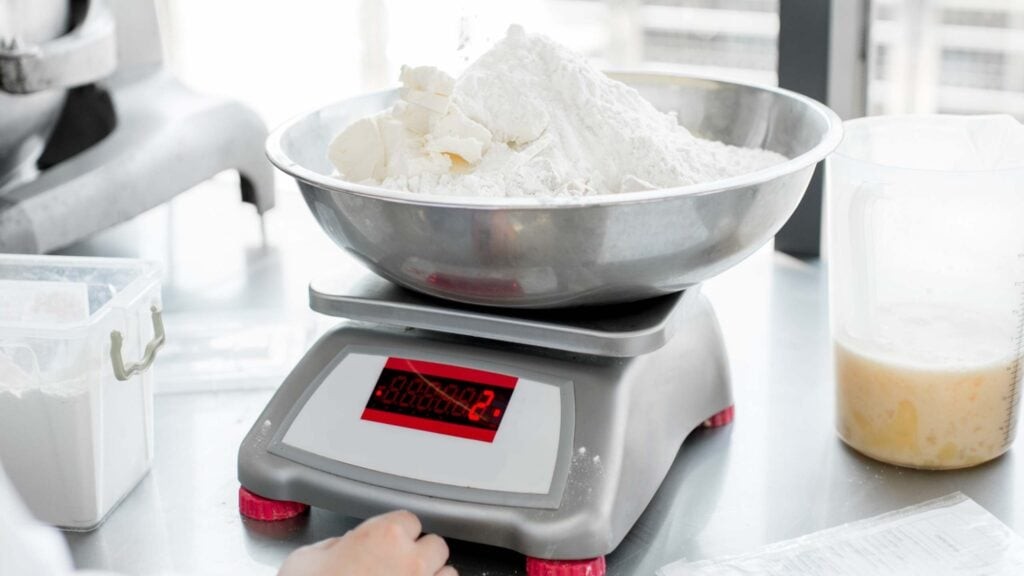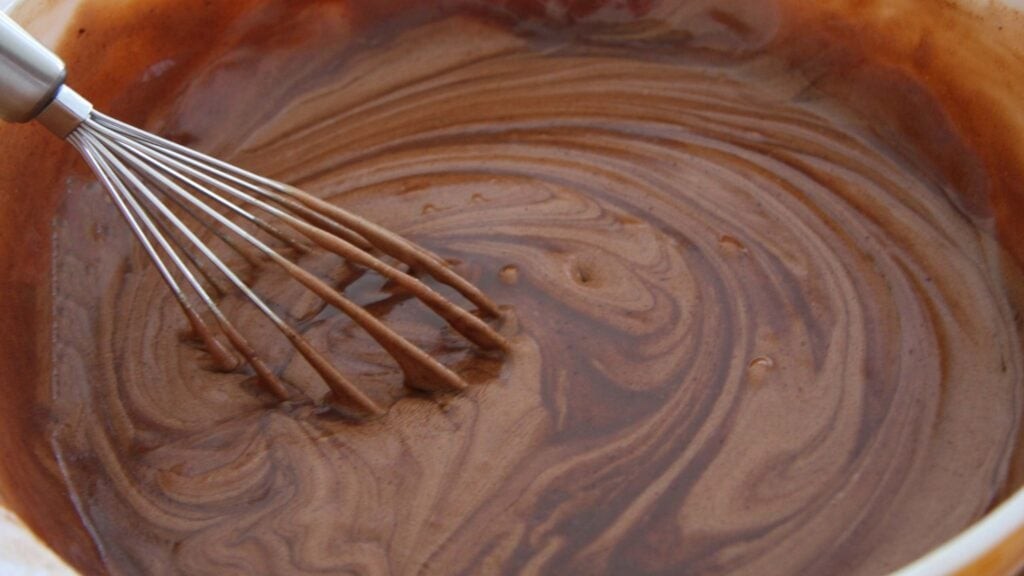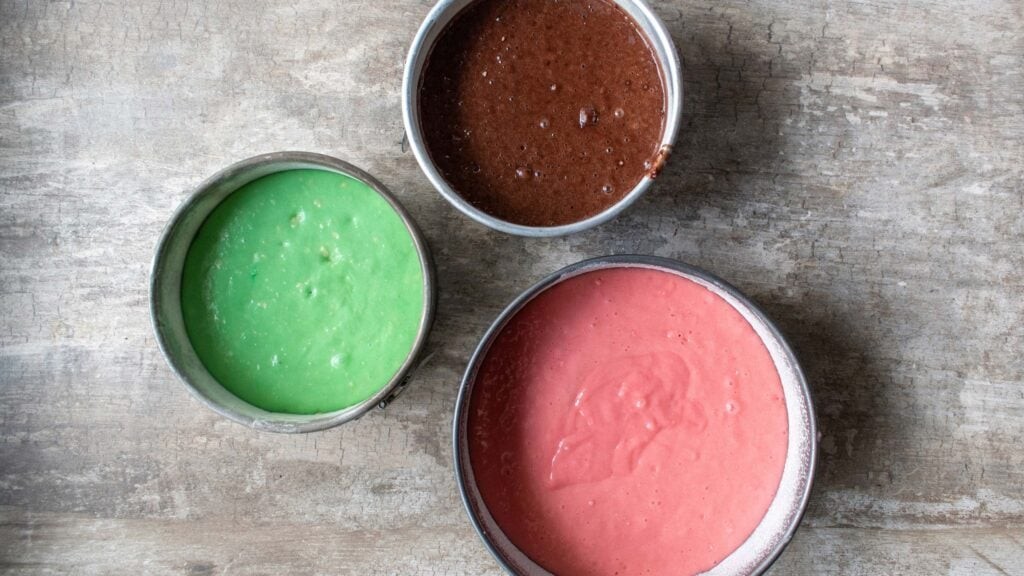Does your cake sink in the middle after baking? This is a common baking problem, but don’t worry! WHY.EDU.VN explains the reasons behind this issue and provides effective solutions for perfectly risen cakes. You’ll learn about ingredient ratios, mixing techniques, oven temperature, and more to prevent sinking cakes, achieve a level top, and enjoy successful baking.
1. Understanding the Science Behind Sinking Cakes
Baking a cake involves a complex interplay of chemical reactions. Achieving a perfectly risen and structurally sound cake relies on several key factors. When a cake sinks in the middle, it indicates an imbalance or disruption in these processes. Understanding the underlying science will empower you to troubleshoot and prevent this frustrating baking mishap.
1.1. The Role of Ingredients
Each ingredient in a cake recipe plays a vital role in its structure, texture, and rise. Flour provides the structure, while eggs contribute to binding and leavening. Sugar adds sweetness and moisture, and fats tenderize the cake. Leavening agents, such as baking powder or baking soda, produce gas that causes the cake to rise.
- Flour: Provides the gluten, which forms the structure of the cake. Too little flour can weaken the structure, leading to sinking.
- Eggs: Add moisture, richness, and binding power. They also contribute to leavening. Too many eggs can make the cake heavy.
- Sugar: Sweetens the cake and keeps it moist. Too much sugar can weaken the structure and cause it to collapse.
- Fat: Tenderizes the cake and adds flavor. Too much fat can make the cake greasy and cause it to sink.
- Leavening Agents: Produce gas that makes the cake rise. Too much or too little can both lead to problems.
1.2. The Importance of Balance
The ratio of these ingredients is crucial. Too much of one ingredient can throw off the balance and compromise the cake’s structure. For example, too much liquid can weaken the gluten structure, causing the cake to sink. Similarly, too much sugar or fat can make the cake too heavy to support its own weight. Accurate measurements are the key to ensuring proper balance.
1.3. The Leavening Process
Leavening agents, such as baking powder and baking soda, are responsible for the cake’s rise. These ingredients release carbon dioxide gas when heated, creating bubbles within the batter. The gluten network traps these bubbles, causing the cake to expand and rise. If the leavening process is disrupted, the cake may not rise sufficiently or may collapse during baking.
1.4. The Role of Temperature
Oven temperature plays a critical role in the baking process. Proper temperature ensures that the cake rises evenly and sets properly. If the oven is too cold, the cake may not rise sufficiently. If the oven is too hot, the cake may rise too quickly and then collapse.
2. Common Reasons Why Cakes Sink
Several factors can contribute to a cake sinking in the middle. Let’s explore some of the most common culprits and how to address them.
2.1. Incorrect Ingredient Ratios
One of the most frequent reasons for a sunken cake is an imbalance in the ingredient ratios. Too much liquid, sugar, or fat can weaken the cake’s structure, making it prone to collapse.
2.1.1. Too Much Liquid
Excessive liquid dilutes the gluten in the flour, weakening the cake’s structure. This can be caused by adding too much milk, water, or other liquid ingredients.
Solution: Carefully measure liquid ingredients using measuring cups or a kitchen scale. Double-check the recipe to ensure you’re using the correct amount.
2.1.2. Too Much Sugar
Sugar is hygroscopic, meaning it attracts and holds water. Too much sugar can weaken the gluten structure and make the cake too moist, leading to sinking.
Solution: Follow the recipe’s sugar measurements precisely. Avoid adding extra sugar, even if you prefer a sweeter cake.
2.1.3. Too Much Fat
Fat tenderizes the cake and adds flavor, but too much fat can make the cake heavy and prone to collapsing. This can be caused by adding too much butter, oil, or other fatty ingredients.
Solution: Measure fat ingredients carefully. Consider using a kitchen scale for accuracy. Avoid substituting fats with higher fat content without adjusting the recipe.
2.2. Improper Mixing Techniques
The way you mix your cake batter can also affect its structure and rise. Overmixing or undermixing can both lead to problems.
2.2.1. Undermixing
Undermixing the batter can result in uneven distribution of ingredients and inadequate gluten development. This can lead to a weak structure and a sunken cake.
Solution: Mix the batter until the ingredients are just combined. Avoid overmixing, but ensure that all ingredients are fully incorporated. Scrape down the sides of the bowl to ensure even mixing.
2.2.2. Overmixing
Overmixing the batter, especially after adding the flour, can develop too much gluten. This can result in a tough, dense cake that doesn’t rise properly and may sink.
Solution: Mix the dry and wet ingredients until just combined. Avoid mixing vigorously or for an extended period. Use a light hand when mixing in the flour.
2.3. Incorrect Oven Temperature
Maintaining the correct oven temperature is crucial for even baking and proper rise. An oven that is too hot or too cold can both cause problems.
2.3.1. Oven Too Cold
If the oven is too cold, the cake may not rise sufficiently, resulting in a dense, heavy cake that sinks in the middle.
Solution: Preheat the oven to the correct temperature before baking. Use an oven thermometer to verify the accuracy of the oven’s thermostat. If the oven runs cold, increase the temperature accordingly.
2.3.2. Oven Too Hot
If the oven is too hot, the cake may rise too quickly and then collapse in the middle. This can also lead to a dry, crusty cake.
Solution: Use an oven thermometer to verify the accuracy of the oven’s thermostat. If the oven runs hot, decrease the temperature accordingly. You can also try placing a baking sheet on the rack above the cake to shield it from direct heat.
2.4. Opening the Oven Door Too Early
Opening the oven door during baking can cause a sudden drop in temperature, which can disrupt the cake’s rising process and cause it to sink.
Solution: Avoid opening the oven door until the cake is nearly done. Use the oven light to check on the cake’s progress. If you must open the door, do so quickly and gently.
2.5. Expired Leavening Agents
Baking powder and baking soda lose their effectiveness over time. Using expired leavening agents can result in a cake that doesn’t rise properly and may sink.
Solution: Check the expiration dates of your baking powder and baking soda. Replace them every 6-12 months, or sooner if they seem less effective. To test baking powder, mix a teaspoon with hot water. It should bubble vigorously. To test baking soda, mix a teaspoon with vinegar. It should also bubble vigorously.
2.6. Using the Wrong Size Cake Pan
Using a cake pan that is too small or too large can affect the cake’s baking time and rise.
2.6.1. Pan Too Small
If the cake pan is too small, the batter may overflow, and the cake may not bake evenly. The weight of the batter may also be too much for the cake to support, causing it to collapse.
Solution: Use the cake pan size specified in the recipe. If you must substitute, adjust the baking time accordingly.
2.6.2. Pan Too Large
If the cake pan is too large, the batter may spread out too thinly, resulting in a flat, dry cake.
Solution: Use the cake pan size specified in the recipe. If you must substitute, adjust the baking time accordingly. You may also need to adjust the amount of batter to ensure that the pan is filled to the correct level.
2.7. High Altitude Baking
Baking at high altitudes can be challenging due to the lower air pressure. This can cause cakes to rise too quickly and then collapse.
Solution: Adjust the recipe for high altitude baking. This may involve reducing the amount of leavening agent, increasing the amount of liquid, and increasing the baking temperature.
Here’s a table summarizing the common causes and solutions for sunken cakes:
| Cause | Solution |
|---|---|
| Incorrect Ingredient Ratios | Measure ingredients accurately using measuring cups or a kitchen scale. Double-check the recipe to ensure you’re using the correct amounts. |
| Undermixing | Mix the batter until the ingredients are just combined. Avoid overmixing, but ensure that all ingredients are fully incorporated. Scrape down the sides of the bowl. |
| Overmixing | Mix the dry and wet ingredients until just combined. Avoid mixing vigorously or for an extended period. Use a light hand when mixing in the flour. |
| Oven Too Cold | Preheat the oven to the correct temperature before baking. Use an oven thermometer to verify the accuracy of the oven’s thermostat. Increase the temperature if needed. |
| Oven Too Hot | Use an oven thermometer to verify the accuracy of the oven’s thermostat. Decrease the temperature if needed. You can also try shielding the cake from direct heat. |
| Opening Oven Door Too Early | Avoid opening the oven door until the cake is nearly done. Use the oven light to check on the cake’s progress. If you must open the door, do so quickly and gently. |
| Expired Leavening Agents | Check the expiration dates of your baking powder and baking soda. Replace them every 6-12 months, or sooner if they seem less effective. |
| Wrong Size Cake Pan | Use the cake pan size specified in the recipe. Adjust baking time accordingly if you must substitute. |
| High Altitude Baking | Adjust the recipe for high altitude baking. This may involve reducing leavening, increasing liquid, and increasing baking temperature. |





3. Step-by-Step Guide to Baking a Perfect Cake
Follow these steps to increase your chances of baking a cake that rises perfectly and doesn’t sink.
- Read the Recipe: Before you begin, read the entire recipe carefully. Make sure you understand all the steps and have all the necessary ingredients and equipment.
- Preheat the Oven: Preheat the oven to the correct temperature. Use an oven thermometer to verify the accuracy of the oven’s thermostat.
- Prepare the Cake Pan: Grease and flour the cake pan. This will prevent the cake from sticking to the pan. You can also line the bottom of the pan with parchment paper.
- Measure Ingredients Accurately: Use measuring cups or a kitchen scale to measure ingredients accurately.
- Cream Butter and Sugar: Cream the butter and sugar together until light and fluffy. This incorporates air into the batter, which helps the cake rise.
- Add Eggs: Add the eggs one at a time, beating well after each addition.
- Combine Dry Ingredients: In a separate bowl, whisk together the dry ingredients, including flour, baking powder, baking soda, and salt.
- Add Dry and Wet Ingredients Alternately: Add the dry and wet ingredients to the creamed mixture alternately, beginning and ending with the dry ingredients. Mix until just combined.
- Pour Batter into Cake Pan: Pour the batter into the prepared cake pan. Spread the batter evenly.
- Bake the Cake: Bake the cake for the time specified in the recipe, or until a wooden skewer inserted into the center comes out clean.
- Cool the Cake: Let the cake cool in the pan for 10-15 minutes before inverting it onto a wire rack to cool completely.
3.1. Advanced Tips for Baking Success
- Use Room Temperature Ingredients: Using room temperature ingredients, especially butter and eggs, helps them emulsify properly, resulting in a smoother batter and a more even texture.
- Sift Dry Ingredients: Sifting dry ingredients, such as flour and cocoa powder, removes lumps and ensures they are evenly distributed in the batter.
- Don’t Overfill the Cake Pan: Overfilling the cake pan can cause the cake to overflow and bake unevenly. Fill the pan about two-thirds full.
- Rotate the Cake: Rotate the cake halfway through baking to ensure it bakes evenly.
- Let the Cake Cool Completely: Letting the cake cool completely before frosting prevents the frosting from melting and sliding off.
4. Troubleshooting Common Cake Problems
Even with careful planning and execution, baking problems can still arise. Here are some common cake problems and how to troubleshoot them:
| Problem | Possible Cause(s) | Solution(s) |
|---|---|---|
| Cake Sinks in Middle | Incorrect ingredient ratios, improper mixing techniques, incorrect oven temperature | Measure ingredients accurately, mix batter properly, verify oven temperature, avoid opening oven door too early, use fresh leavening agents, use the correct size cake pan, adjust recipe for high altitude baking. |
| Cake is Dry | Overbaking, too much flour, not enough fat | Bake for the correct amount of time, measure flour accurately, add more fat to the recipe. |
| Cake is Dense | Undermixing, too much liquid, not enough leavening agent | Mix batter properly, reduce liquid, add more leavening agent. |
| Cake is Crumbly | Too much fat, not enough gluten development | Reduce fat, use bread flour or add vital wheat gluten to the recipe. |
| Cake Sticks to the Pan | Not greasing and flouring the pan properly | Grease and flour the pan thoroughly, line the bottom of the pan with parchment paper. |
| Cake is Uneven | Oven not level, cake pan not level | Use an oven thermometer to verify the oven temperature, make sure the cake pan is level. |
| Cake is Overbaked | Oven temperature too high, cake baked too long | Use an oven thermometer to verify the oven temperature, reduce the baking time. |
5. The Science of Cake Baking: A Deeper Dive
Let’s delve deeper into the science behind cake baking to understand the chemical reactions and physical changes that occur during the process.
5.1. The Maillard Reaction
The Maillard reaction is a chemical reaction between amino acids and reducing sugars that occurs when food is heated. This reaction is responsible for the browning and flavor development in baked goods, including cakes. The Maillard reaction is influenced by temperature, pH, and the presence of moisture.
5.2. Gluten Development
Gluten is a protein complex formed when flour is mixed with water. Gluten provides structure and elasticity to the cake batter. The amount of gluten development affects the cake’s texture. Overmixing develops too much gluten, resulting in a tough cake. Undermixing doesn’t develop enough gluten, resulting in a weak structure.
5.3. Starch Gelatinization
Starch gelatinization is the process by which starch granules absorb water and swell when heated. This process contributes to the cake’s structure and texture. Starch gelatinization occurs at a specific temperature range, which varies depending on the type of starch.
5.4. Fat Melting
Fat melts during baking, tenderizing the cake and adding flavor. The type of fat used affects the cake’s texture and flavor. Butter adds a rich flavor and tender texture. Oil adds moisture and a more delicate texture.
5.5. Egg Coagulation
Egg proteins coagulate when heated, providing structure and binding to the cake. Egg coagulation occurs at a specific temperature range. Overcooking eggs can result in a dry, rubbery cake.
6. Recipes for Success: Cakes That Won’t Sink
Here are some cake recipes that are known for their reliable results and resistance to sinking:
6.1. Classic Vanilla Cake
This classic vanilla cake recipe is a foolproof option for beginners and experienced bakers alike.
Ingredients:
- 2 1/2 cups all-purpose flour
- 1 tablespoon baking powder
- 1/2 teaspoon salt
- 1 cup (2 sticks) unsalted butter, softened
- 1 3/4 cups granulated sugar
- 2 large eggs
- 1 teaspoon vanilla extract
- 1 1/4 cups milk
Instructions:
- Preheat oven to 350°F (175°C). Grease and flour a 9×13 inch baking pan.
- In a large bowl, whisk together flour, baking powder, and salt.
- In a separate bowl, cream together butter and sugar until light and fluffy.
- Beat in eggs one at a time, then stir in vanilla extract.
- Gradually add the dry ingredients to the wet ingredients, alternating with the milk, beginning and ending with the dry ingredients. Mix until just combined.
- Pour batter into the prepared pan and spread evenly.
- Bake for 30-35 minutes, or until a wooden skewer inserted into the center comes out clean.
- Let cool in the pan for 10 minutes before inverting onto a wire rack to cool completely.
6.2. Chocolate Cake
This rich and moist chocolate cake recipe is sure to impress.
Ingredients:
- 2 cups all-purpose flour
- 2 cups granulated sugar
- 3/4 cup unsweetened cocoa powder
- 1 1/2 teaspoons baking powder
- 1 1/2 teaspoons baking soda
- 1 teaspoon salt
- 1 cup buttermilk
- 1/2 cup vegetable oil
- 2 large eggs
- 2 teaspoons vanilla extract
- 1 cup boiling water
Instructions:
- Preheat oven to 350°F (175°C). Grease and flour a 9×13 inch baking pan.
- In a large bowl, whisk together flour, sugar, cocoa powder, baking powder, baking soda, and salt.
- Add buttermilk, oil, eggs, and vanilla extract. Beat until well combined.
- Gradually add the boiling water to the batter, mixing until smooth. The batter will be thin.
- Pour batter into the prepared pan and spread evenly.
- Bake for 30-35 minutes, or until a wooden skewer inserted into the center comes out clean.
- Let cool in the pan for 10 minutes before inverting onto a wire rack to cool completely.
6.3. Pound Cake
Pound cake is a dense and buttery cake that is perfect for slicing and serving with fruit or whipped cream.
Ingredients:
- 1 cup (2 sticks) unsalted butter, softened
- 2 cups granulated sugar
- 4 large eggs
- 2 teaspoons vanilla extract
- 3 cups all-purpose flour
- 1/2 teaspoon salt
- 1/2 cup milk
Instructions:
- Preheat oven to 325°F (165°C). Grease and flour a 9×5 inch loaf pan.
- In a large bowl, cream together butter and sugar until light and fluffy.
- Beat in eggs one at a time, then stir in vanilla extract.
- In a separate bowl, whisk together flour and salt.
- Gradually add the dry ingredients to the wet ingredients, alternating with the milk, beginning and ending with the dry ingredients. Mix until just combined.
- Pour batter into the prepared pan and spread evenly.
- Bake for 60-70 minutes, or until a wooden skewer inserted into the center comes out clean.
- Let cool in the pan for 10 minutes before inverting onto a wire rack to cool completely.
7. Expert Opinions on Preventing Sinking Cakes
According to professional bakers, several key techniques can help prevent cakes from sinking.
7.1. Preheating and Oven Consistency
“Ensuring your oven is properly preheated and maintains a consistent temperature is crucial,” says Chef Emily Thompson, a pastry chef with over 15 years of experience. “Use an oven thermometer to check for temperature fluctuations and adjust accordingly.”
7.2. Ingredient Quality and Measurements
“High-quality ingredients and precise measurements are non-negotiable,” advises renowned baker Chef James Oliver. “Always use fresh leavening agents, and measure your dry and wet ingredients with equal care to maintain the perfect balance.”
7.3. Mixing Techniques
“The key to a well-risen cake often lies in the mixing technique,” explains Chef Sarah Miller, a baking instructor. “Creaming butter and sugar properly to incorporate air, and gently folding in dry ingredients to avoid overmixing, makes a significant difference.”
7.4. Cooling Process
“How you cool your cake is just as important as how you bake it,” notes Chef Michael Brown, a cake decorating expert. “Allowing the cake to cool gradually in the pan before transferring it to a wire rack prevents sudden temperature changes that can cause sinking.”
8. Real-World Baking Scenarios and Solutions
Here are some practical baking scenarios with solutions to prevent cakes from sinking:
8.1. Baking a Gluten-Free Cake
Problem: Gluten-free cakes often lack structure and tend to sink.
Solution: “Use a blend of gluten-free flours like almond, rice, and tapioca flour,” suggests gluten-free baking expert Laura Davis. “Add xanthan gum to mimic gluten’s elasticity, and ensure your wet and dry ingredients are perfectly balanced.”
8.2. Adjusting Recipes for High Altitude
Problem: Cakes rise rapidly and then collapse at high altitudes.
Solution: “Reduce the amount of baking powder by about 25% and increase the liquid by a tablespoon or two,” advises high-altitude baking specialist Anna Green. “Also, increase the oven temperature slightly to help the cake set faster.”
8.3. Baking with Alternative Sweeteners
Problem: Using alternative sweeteners can affect the cake’s moisture and structure.
Solution: “When using sweeteners like honey or maple syrup, reduce the liquid in the recipe,” recommends nutritionist and baking enthusiast Lisa Adams. “Consider adding a tablespoon of cornstarch to help stabilize the batter.”
9. Frequently Asked Questions (FAQ) About Sinking Cakes
Here are some frequently asked questions about why cakes sink in the middle:
- Why does my cake sink every time I bake it? Several factors can cause this, including incorrect ingredient ratios, improper mixing techniques, and incorrect oven temperature. Review the tips in this article to identify the cause.
- How can I tell if my oven temperature is accurate? Use an oven thermometer to verify the accuracy of the oven’s thermostat.
- Is it better to use butter or oil in cake recipes? Butter adds a rich flavor and tender texture, while oil adds moisture and a more delicate texture. Choose the fat that best suits the recipe and your preferences.
- Can I substitute one type of flour for another in cake recipes? It’s generally best to use the type of flour specified in the recipe. If you must substitute, be aware that it may affect the cake’s texture and rise.
- How long should I let the cake cool before frosting it? Let the cake cool completely before frosting it to prevent the frosting from melting and sliding off.
- What is the best way to store a cake? Store cake in an airtight container at room temperature for up to 3 days or in the refrigerator for up to a week.
- Can I freeze a cake? Yes, you can freeze a cake. Wrap the cake tightly in plastic wrap and then in foil. Freeze for up to 3 months.
- What are some common mistakes that cause cakes to sink? Common mistakes include using expired leavening agents, opening the oven door too early, and overmixing the batter.
- How do I adjust my cake recipe for high altitude baking? Reduce the amount of leavening agent, increase the amount of liquid, and increase the baking temperature.
- Is there a way to fix a cake that has already sunk? Unfortunately, there’s no way to fix a cake that has already sunk. However, you can still use the cake to make other desserts, such as trifles or cake pops.
10. Embrace the Baking Journey with WHY.EDU.VN
Baking a perfect cake can be a rewarding experience. By understanding the science behind cake baking and following these tips, you can increase your chances of success and prevent your cakes from sinking. Remember, practice makes perfect. Don’t be discouraged if your first few attempts aren’t perfect. Keep experimenting and learning, and you’ll eventually master the art of cake baking.
Do you have more baking questions or need expert advice? Visit WHY.EDU.VN at 101 Curiosity Lane, Answer Town, CA 90210, United States or contact us via Whatsapp at +1 (213) 555-0101. At WHY.EDU.VN, we provide detailed, easy-to-understand answers based on expert knowledge. Our platform offers a community where you can ask questions and get fast, accurate responses from specialists.
Whether you’re seeking assistance with academic inquiries or require specialized knowledge, WHY.EDU.VN is here to help. We aim to offer dependable solutions, compare diverse viewpoints, and foster a helpful community. Explore WHY.EDU.VN today to discover answers and broaden your understanding. Don’t let your curiosity wait—find the solutions you need with why.edu.vn.
